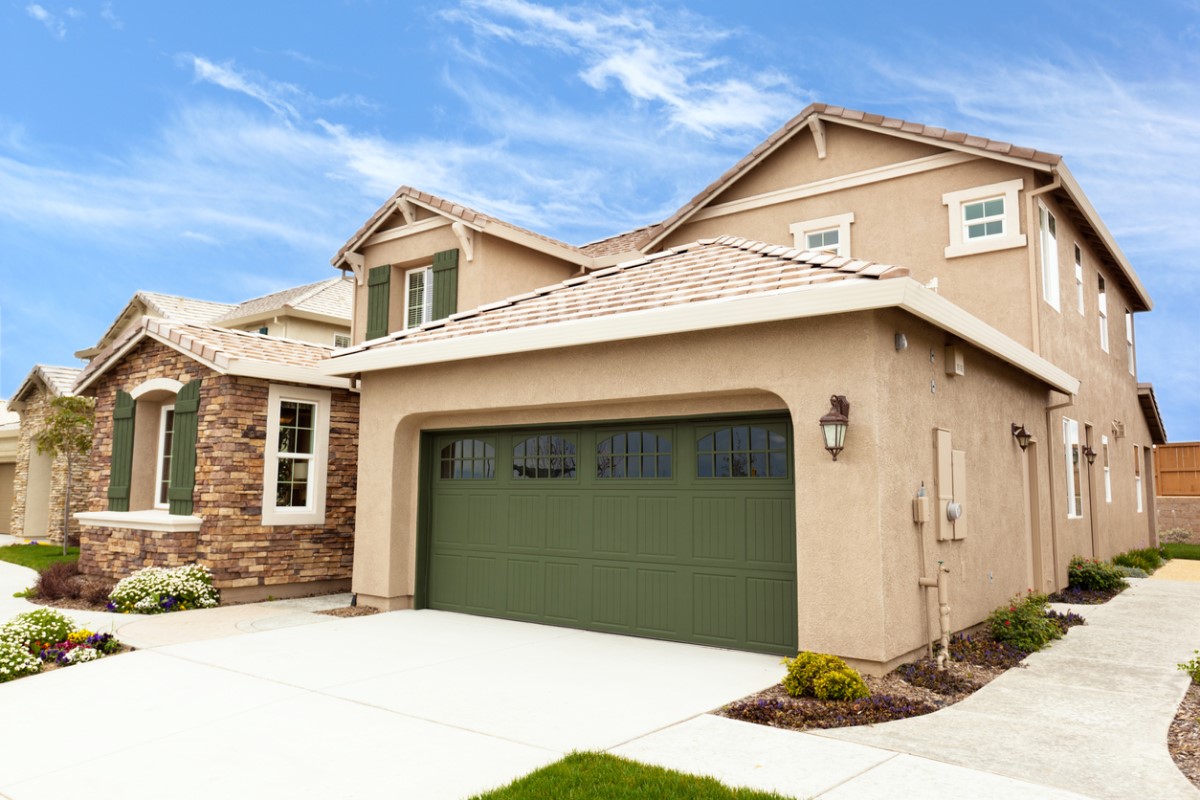

We may earn revenue from the products available on this page and participate in affiliate programs. Learn More ›
As cars have grown more important to our lives, they have gained equal prominence in residential floor plans. You’d probably be hard-pressed to find a single-family house built in the last 30 years where the first thing you noticed wasn’t the garage door. In the day-to-day life of today’s home, the garage is so central that many people use it as the primary entrance!
Over the last decade or so, advancements in technology have enabled garage door manufacturers and architects to improve the curb appeal as well as the durability of this entrance—all of which benefits the homeowner who is looking to boost his or home’s value. Sometimes it seems that faux wooden carriage-style doors are now to home exteriors what granite countertops are to kitchens! From high-end to budget-friendly, there are plenty of decidedly attractive options to consider for this prominent facade feature.
RELATED: The Dos and Don’ts of Choosing a New Garage Door
First, decide on the type of garage door construction.
A sectional door is the most common option in the US, which has several horizontal panels hinged together and fitted with rollers.
The entire assembly rides in two parallel tracks. A heavy-duty torsion spring, which is in turn wrapped around a torsion bar, serves to counterbalance the weight of the door. Homeowners are able to lift the door either manually or by switching on a motorized garage door opener. The actual lifting may be chain-, belt-, screw- or direct-driven.
Sectional doors are available with or without windows. Options for the former include up to 16 panes in several shapes, including square and arched. And there are many decorative styles too, from contemporary to traditional. Sectional doors are even available in the popular carriage-house style, described next; these look like swing-style doors but work the same as sectional doors.
True carriage or swing-style garage doors operate like a pair of very big French doors.
They are typically made of wood and hang from jambs on hinges. Swing-style doors look good, with their strong vertical lines often helping to integrate the garage with the rest of the home. In addition, swinging doors tend to be more energy-efficient, because they seal well at the header and side jambs and only have one joint.
They do, however, require more clearance. If you park too close to swinging doors, you won’t be able to open them. Also remember that swinging garage doors are more time-consuming to manually open and lock than sectional doors, and they’re much more expensive to automate.

Then, consider all of the options for garage door materials.
Like entry doors, garage doors can be made of steel, aluminum, wood, wood composites, fiberglass, vinyl, or glass. Real or faux, the wood look tends to be the most popular.
1. Steel garage doors
The best steel garage doors are made of two layers of galvanized steel, the surface of which is either primed and painted with a tough topcoat finish or clad with a composite material. Steel doors can be painted to match your home and are available with or without insulation. The downside of steel doors is that they can be dented and are subject to corrosion, especially in coastal areas.
2. Wood garage doors
Wood garage doors are built with layers, or plies, to prevent warping. Woods include cedar, redwood, fir, and meranti (luan). Wood doors may be factory-stained or painted or finished on-site.

3. Wood composite garage doors
Composite garage doors typically have a wood frame covered with sheets of fiberboard. Better models offer higher-density fiberboard skins and include realistic details, such as overlays and grooves to simulate a real wood door. Cores are filled with polystyrene insulation.
4. Aluminum frame garage doors
Garage doors fitted with aluminum panels eliminate the problem of rust but are easier to dent. They are available in contemporary brushed finishes, as well as in many colors. (Translucent glass panels may be used in place of aluminum panels; these admit daylight without compromising privacy or security.)
5. Fiberglass garage doors
Garage doors made from fiberglass are less subject to denting or cracking. They do not rust but can break upon impact. Two layers of fiberglass are typically bonded to a steel frame and filled with polyurethane insulation. Steel end caps help improve rigidity.
6. Vinyl garage doors
Vinyl garage doors are promoted as being ‘kid-proof,’ because they are difficult to dent or break. Typically built upon steel frames, these too are filled with polyurethane insulation. Vinyl doors look similar to fiberglass doors but are available in fewer colors. They are very durable and require little maintenance aside from an occasional hosing.
